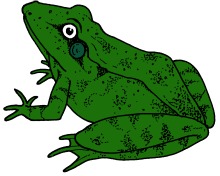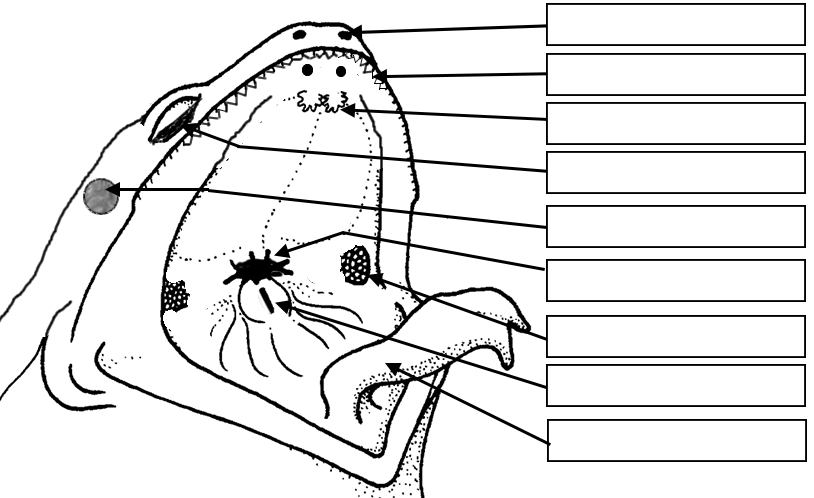Frog Dissection: External Anatomy

1. Observe the dorsal and ventral sides of the frog.
Dorsal side color ___________ Ventral side color ____________
2. Examine the hind legs. How many toes are present on each foot? ______
Are they webbed? _____
3. Examine the forelegs. How many toes are present? _____Are the toes webbed? _____
4. Use a ruler to measure your from the tip of the head to the end
of the frog's backbone.
Compare the length of your frog to other frogs ![]()
| Your Frog (cm) | Frog 2 | Frog 3 | Frog 4 | Frog 5 | Average Length |
5. Locate the frog's eyes, the nictitating membrane is a clear membrane that attached
to the bottom of the eye. Use tweezers to carefully remove the nictitating membrane. You may also remove the eyeball. ![]()
What color is the nictitating membrane? _____________ What color is the eyeball? _________________
6. Just behind the eyes on the frog's head is a circular structure called the tympanic membrane. The tympanic membrane is used for hearing. Measure the diameter (distance across the circle) of the tympanic membrane. Diameter of tympanic membrane = _______cm
7. Feel the frog's skin. Is it scaley or is it slimy? ____________
Anatomy of the Frog's Mouth
Procedure: Pry the frog's mouth open and use scissors to cut the angles of the frog's jaws open. Cut deeply so that the frog's mouth opens wide enough to view the structures inside.
1. Locate the tongue. Play with the tongue. Does it attach to the front or the back of the mouth? __________ (You may remove the tongue). Draw a sketch of the tongue, paying attention to its shape.
Tongue Sketch:
2. In the center of the mouth, toward the back is a single round opening, the esophagus. This tube leads to the stomach. Use a probe to poke into the esophagus.
3. Close to the angles of the jaw are two openings, one on each side. These are the Eustachian tubes. They are used to equalize pressure in the inner ear while the frog is swimming. Insert a probe into the Eustachian tube.
To what structure does the Eustachian tube attach? _____________________
4. Just behind the tongue, and before you reach the esophagus is a slit like opening. (You may need to use your probe to get it to open up). This slit is the glottis, and it is the opening to the lungs. The frog breathes and vocalizes with the glottis. Use your probe to open the glottis and compare that opening to the esophagus.
5. The frog has two sets of teeth. The vomerine teeth are found on the roof of the mouth. The maxillary teeth are found around the edge of the mouth. Both are used for holding prey, frogs swallow their meals whole and do NOT chew. Run you finger over both sets of teeth and note the differences between them.
6. On the roof of the mouth, you will find the two tiny openings of the nostrils, if you put your probe into those openings, you will find they exit on the outside of the frog.
7. Label each of the structures.
8. Complete the table.
| Structure | Function | Location |
| Vomerine Teeth | ||
| Eustachian Tubes | ||
| Tympanic Membrane | ||
| Esophagus | ||
| Glottis | ||
| Tongue |
Other Resources on the Frog
Frog Dissection - complete guide to the frog dissection, covering internal structures
Frog Brain and Bones – remove the frog’s brain, expose the bones of the lower leg
Frog Dissection Crossword – review terms and procedures
Frog Dissection Alternative – for students who do not wish to dissect a frog, project using internet resources
Frog Anatomy Review – resource site for virtual frogs and practice quizzes
Frog Anatomy Labeling – basic pictures of frogs for students to label, serves as a review for the lab test
Frog Dissection Gallery - photos of the frog with labeled structures
Frog Dissection Kit from Amazon


